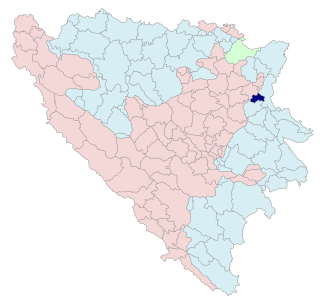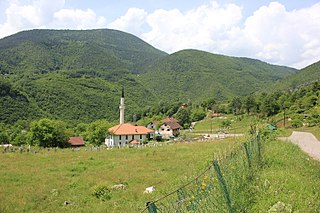Crni Vrh, meaning "black peak" in Bosnian-Croatian-Serbian, may refer to:

The Srebrenica massacre, also known as the Srebrenica genocide, was the July 1995 genocidal killing of more than 8,000 Bosniak Muslim men and boys in and around the town of Srebrenica during the Bosnian War. It was mainly perpetrated by units of the Bosnian Serb Army of Republika Srpska under Ratko Mladić, though the Serb paramilitary unit Scorpions also participated. The massacre was the first legally recognised genocide in Europe since the end of World War II.

Dragan Obrenović is a former Bosnian Serb senior officer and commander in the Yugoslav People's Army (JNA) and the Bosnian Serb Army (VRS).

Osmaci is a town and municipality in Republika Srpska, Bosnia and Herzegovina. As of 2013, it has a population of 6,016 inhabitants. There is also a small, uninhabited, part of Osmaci that is in Kalesija municipality.

Žepa is a village located in the municipality of Rogatica, Republika Srpska, Bosnia and Herzegovina. As of 2013 census, it has a population of 133 inhabitants. It is situated northeast of Rogatica itself on the banks of short river with a same name, the Žepa river, which flows into the Drina river nearby, in a valley between the mountains Javor and Devetak.
The Korićani Cliffs massacre was the mass murder of more than 200 Bosniak and Bosnian Croat men on 21 August 1992, during the Bosnian War, at the Korićani Cliffs on Mount Vlašić in central Bosnia and Herzegovina.

The Višegrad massacres were acts of mass murder committed against the Bosniak civilian population of the town and municipality of Višegrad during the ethnic cleansing of eastern Bosnia by Republika Srpska police and military forces during the spring and summer of 1992, at the start of the Bosnian War.

The siege of Srebrenica was a three-year siege of the town of Srebrenica in eastern Bosnia and Herzegovina which lasted from April 1992 to July 1995 during the Bosnian War. Initially assaulted by the Yugoslav People's Army (JNA) and the Serbian Volunteer Guard (SDG), the town was encircled by the Army of Republika Srpska (VRS) in May 1992, starting a brutal siege which was to last for the majority of the Bosnian War. In June 1995, the commander of the Army of the Republic of Bosnia and Herzegovina (ARBiH) in the enclave, Naser Orić, left Srebrenica and fled to the town of Tuzla. He was subsequently replaced by his deputy, Major Ramiz Bećirović.
The Kravica massacre was one of the mass executions of Bosniaks by the Army of Republika Srpska during the Srebrenica massacre. It was committed on 14 July, 1995. It is estimated that between 1,000 and 1,500 men were killed.
Hajvazi is a village in the municipality of Osmaci, Bosnia and Herzegovina.

Donji Potočari is a village located in the municipality of Srebrenica, Republika Srpska, Bosnia and Herzegovina. As of 2013 census, the village has a population of 705 inhabitants.

Amor Mašović, is a Bosnian politician and Chairman of the Bosnian Federal Commission for Missing Persons. During the Bosnian War, Amor Mašović was the person responsible on the Bosnian government side for negotiating prisoner exchanges and was involved in the ultimately fruitless negotiations for the exchange of Col. Avdo Palić, the "disappeared" commander of the enclave of Žepa.
Tomašica is a village in Bosnia and Herzegovina in the Prijedor municipality of the Republika Srpska entity.
Liplje is a mountain village located in the municipality of Zvornik, Bosnia and Herzegovina, neighboring Snagovo. Within Liplje there are 14 settlements: Bajrići, Bećirovići, Čamlija, Hadžići, Husići, Jašići, Jošanica, Kadrići, Korin Brijeg, Liplje, Salihovići, Samari, Sultanovići and Velja Glava.

Snagovo is a mountain village in the municipality of Zvornik, Bosnia and Herzegovina. It is divided into Gornje Snagovo and Donje Snagovo.

The Snagovo massacre refers to the mass killing of 36 Bosnian Muslim civilians by Serbs on 29 April 1992 in the village Snagovo, located in the municipality of Zvornik, Bosnia and Herzegovina. The massacre occurred at the start of the Bosnian War.
The Bijeli Potok massacre refers to the mass killing of 675 Bosniak civilians by Serbs on 1 June 1992 in the settlement Bijeli Potok within the village Đulići, located in the municipality of Zvornik, Bosnia and Herzegovina. About 675 Bosniak men and boys, from the multiple villages around Zvornik, were separated from their families by Serb forces, and slaughtered within a week at Bijeli Potok and their bodies hidden in mass graves throughout the Drina Valley.

Crni Vrh is a mountain in eastern Bosnia and Herzegovina, near Zvornik. A mass grave containing Bosniak victims of the Bosnian War was uncovered on mountain slope near Snagovo.
On 12 July 1992, a total of 69 Bosnian Serb soldiers and civilians were killed in the villages of Zalazje and Sase in the municipality of Srebrenica, and Biljača and Zagoni in the municipality of Bratunac, after an attack by the Army of the Republic of Bosnia and Herzegovina (ARBiH). It occurred during the Bosnian War.










